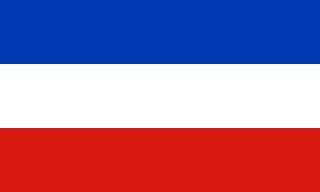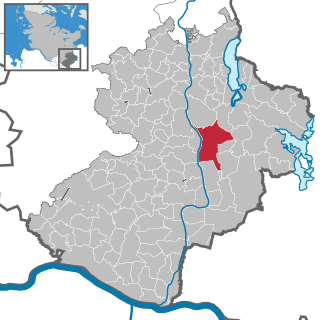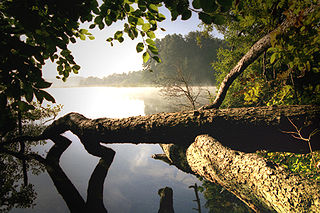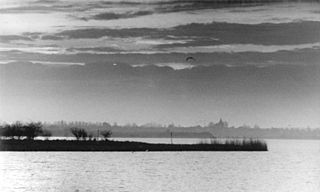
Schleswig-Holstein is the northernmost of the 16 states of Germany, comprising most of the historical duchy of Holstein and the southern part of the former Duchy of Schleswig. Its capital city is Kiel; other notable cities are Lübeck and Flensburg.
Stormarn is a district in Schleswig-Holstein, Germany. It is bounded by the districts of Segeberg and Ostholstein, the city of Lübeck, the district of Lauenburg, and the city-state of Hamburg.
Herzogtum Lauenburg is the southernmost Kreis, or district, of Schleswig-Holstein, Germany. It is bordered by the district of Stormarn, the city of Lübeck, the state of Mecklenburg-Vorpommern, the state of Lower Saxony, and the city state of Hamburg. The district of Herzogtum Lauenburg is named after the former Duchy of Saxe-Lauenburg.

Mölln is a town in Schleswig-Holstein, Germany. It is surrounded by several small lakes. The Elbe-Lübeck Canal flows through the town. Mölln belongs to the district of Herzogtum Lauenburg.

The Elbe–Lübeck Canal is an artificial waterway in eastern Schleswig-Holstein, Germany. It connects the rivers Elbe and Trave, creating an inland water route across the drainage divide from the North Sea to the Baltic Sea. The canal includes seven locks and runs for a length of 64 kilometres (40 mi) between the cities of Lübeck in the north and Lauenburg in the south by way of the Mölln lakes. The modern canal was built in the 1890s to replace the Stecknitz Canal, a medieval watercourse linking the same two rivers.
Nordwestmecklenburg is a Kreis (district) in the north-western part of Mecklenburg-Vorpommern, Germany. It is situated on the coast of the Baltic Sea and borders on Schleswig-Holstein to the west. Neighboring districts are Rostock, Ludwigslust-Parchim and the district-free city Schwerin, and the district Lauenburg and the district-free city Lübeck in Schleswig-Holstein. The district seat is the town Wismar.

The Trave is a river in Schleswig-Holstein, Germany. It is approximately 124 kilometres (77 mi) long, running from its source near the village of Gießelrade in Ostholstein to Travemünde, where it flows into the Baltic Sea. It passes through Bad Segeberg, Bad Oldesloe, and Lübeck, where it is linked to the Elbe–Lübeck Canal. It is navigable for sea-going vessels from the Baltic to the Lübeck ports. The Herren Tunnel crosses the Trave, as do numerous bridges, and a ferry connects Travemünde with Priwall. Tributaries of the Trave include the Wakenitz and the Stepenitz.

Schaalsee is a 24 km2 (9.3 sq mi) lake in Germany. It forms part of the border between Schleswig-Holstein and Mecklenburg-Vorpommern. The town of Zarrentin is located on its southern shores. Other municipalities on the lake are Seedorf, Sterley, Salem, Kittlitz and Kneese.

The Mecklenburg Lake Plateau or Mecklenburg Lakeland is the largest coherent lake and canal region in Germany and is sometimes called "the land of a thousand lakes". There are several nature parks and well-known lakes with unique flora and fauna in the region, such as the Müritz, the biggest German lake lying entirely within Germany, the Plauer See, the Fleesensee, the Tollensesee, the Schmaler Luzin and the Kölpinsee.

The Großer Plöner See or Lake Plön is the largest lake (30 km²) in Schleswig-Holstein, Germany. It is located near the town of Plön. Its main tributary, as well as its main outflow, is the River Schwentine.

Despite its name, the Dassower See , sometimes called Lake Dassow or Dassow Bay in English, is not a lake, but a side bay, locally known as a wiek, of the Trave Fjord, northeast of Lübeck (Schleswig-Holstein) on the Baltic Sea.

Kneese is a municipality in the south west of the Nordwestmecklenburg district, in the Federal State of Mecklenburg-Vorpommern, Germany. The municipality is governed by the government office Gadebusch in the city Gadebusch.

Holstein Switzerland is a hilly area with a patchwork of lakes and forest in Schleswig Holstein, Germany, reminiscent of Swiss landscape. Its highest point is the Bungsberg. It is a designated nature park as well as an important tourist destination in Northern Germany situated between the cities of Kiel and Lübeck.

The Schleswig-Holstein Uplands or Schleswig-Holstein Morainic Uplands is one of the three landscapes of the German state of Schleswig-Holstein; the others being the marsch and the geest. In addition, the gently rolling hills or Hügelland of the Baltic Uplands, the many small lakes and the long, deep embayments (Förde) formed by the moraines of the Weichselian Ice Age are characteristic features of the area. Its best-known towns are Kiel, Lübeck and Flensburg. The highest elevation in the area is the Bungsberg in the region known as Holstein Switzerland. On the Bungsberg is the only ski lift in the state.

Delvenau is a 50-kilometre-long (31 mi) river in Herzogtum Lauenburg in Schleswig-Holstein, Germany. It begins in Büchen, flows to the Elbe–Lübeck Canal near its confluence with the Elbe in Lauenburg. The lower section between Bröthen and Lauenburg forms the border between Schleswig-Holstein and Mecklenburg-Vorpommern.

The Schaalsee Biosphere Reserve lies in western Mecklenburg-Vorpommern on its border with Schleswig-Holstein. From 1952 to 1990 large parts of the Schaalsee landscape lay within the military out of bounds area of the Inner German Border. That state-imposed rest period enable nature to develop so that in the year 2000 this valuable area was designated as a biosphere reserve. On the Schleswig-Holstein side of the border is the Lauenburg Lakes Nature Park founded in 1961.

The Mecklenburg Elbe Valley Nature Park is part of the UNESCO biosphere reserve of Elbe River Landscape, which is over 400 river kilometres long and which runs through the five German states of Saxony-Anhalt, Brandenburg, Lower Saxony, Mecklenburg-Vorpommern and Schleswig-Holstein. It lies in the district of Ludwigslust-Parchim in Mecklenburg-Vorpommern. The nature park was called into existence in 1990 and legally established by act of state in 1998. It has an area of 426 km2 (164 sq mi).

The Evangelical Lutheran Church in Northern Germany is a Lutheran member church of the Evangelical Church in Germany. It was established on 27 May 2012 as a merger of the North Elbian Evangelical Lutheran Church, the Evangelical Lutheran Church of Mecklenburg, and the Pomeranian Evangelical Church. It covers the combined area of all those former member churches, which are the federal states of Schleswig-Holstein, Hamburg and Mecklenburg-Vorpommern. Nordkirche is the only Landeskirche in Germany which covers parts of both New states of Germany and West Germany. It is also called Nordkirche. It has 1,939,750 members (31/12/2019). There are 1,704 ordained pastors and more than 84,000 volunteers working for Nordkirche (4/2016).

The North Sea-Baltic Sea Continental Divide in Europe begins at the triple point between the North Sea, Baltic Sea and the Norwegian Sea. This point is located in the vicinity of the Skarddøssjøan Lake on the border between Norway and Sweden. From here, the divide extends southwards along the border between Norway and Sweden. On the European mainland, the North Sea-Baltic Sea Continental Divide runs through Denmark as well as the German states of Schleswig-Holstein, Mecklenburg-Vorpommern, Brandenburg and Sachsen. From there it routes along the border between Poland and the Czech Republic until it reaches the main European Continental Divide, ending at the triple point between the North Sea, Baltic Sea and Black Sea at the Králický Sněžník.


















